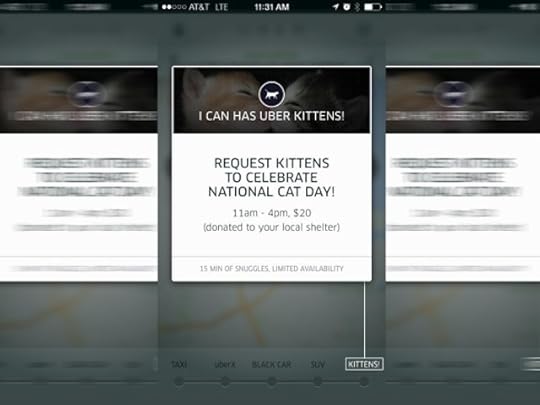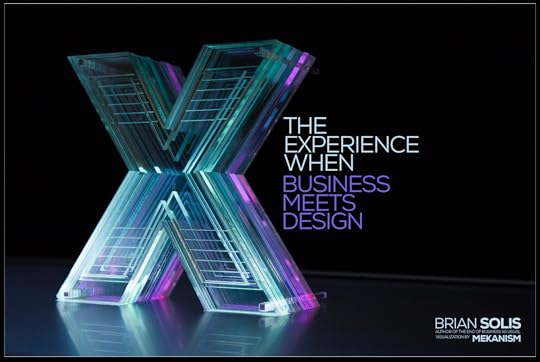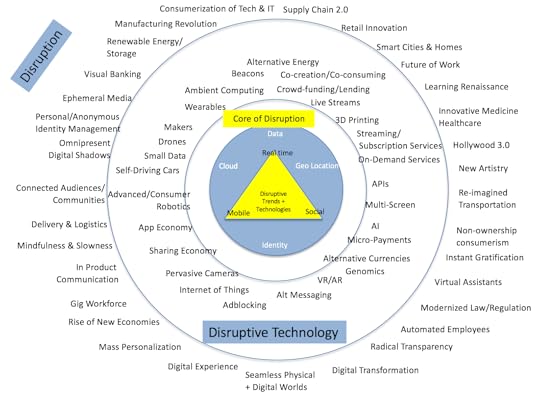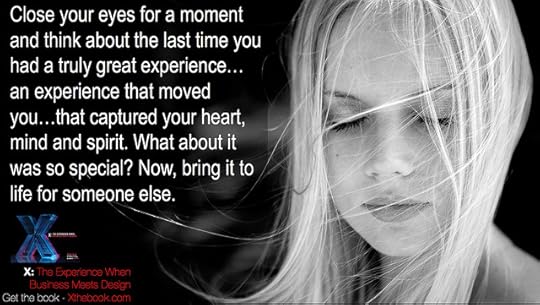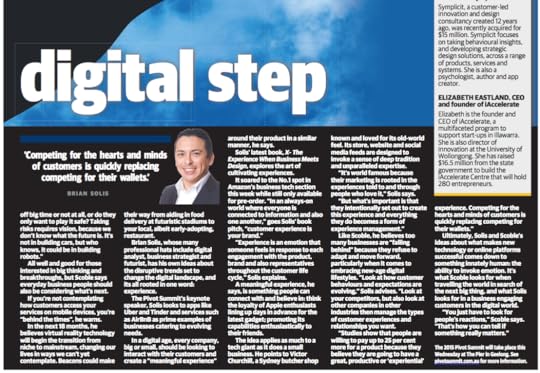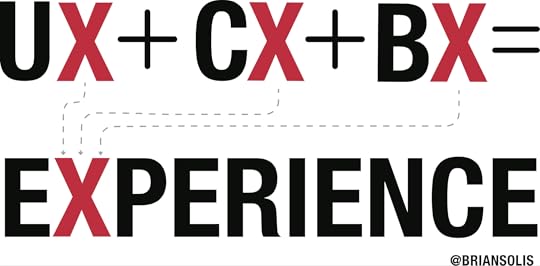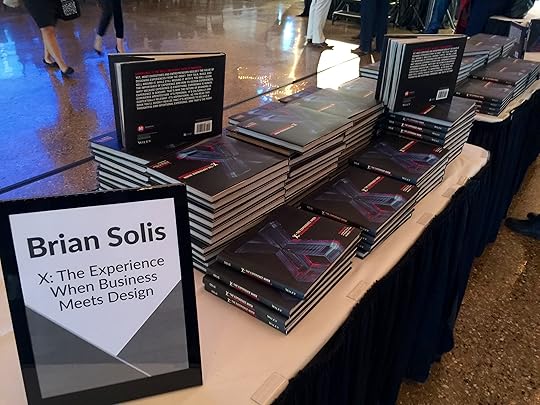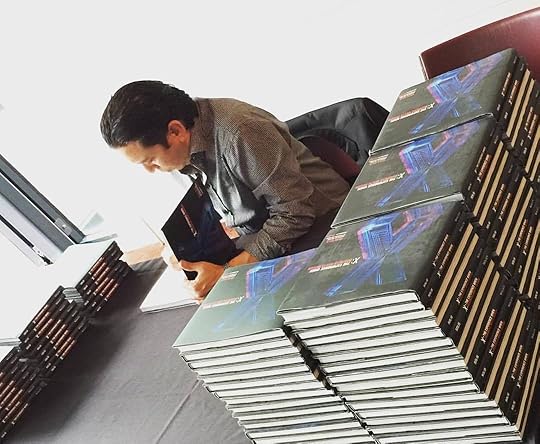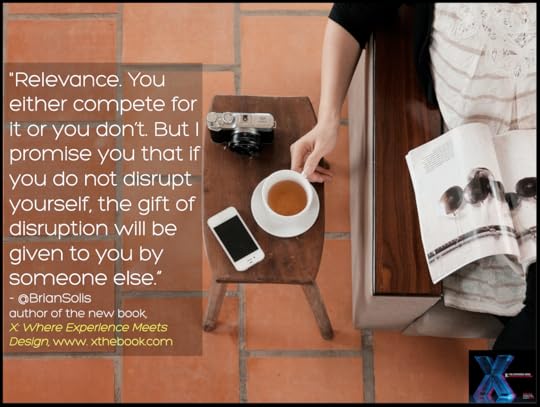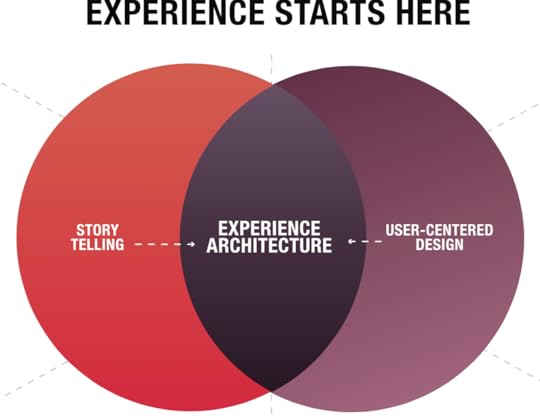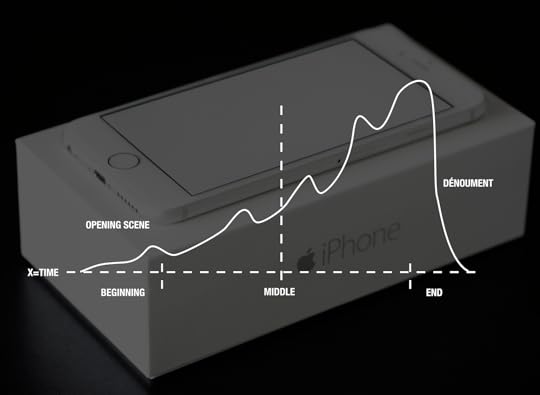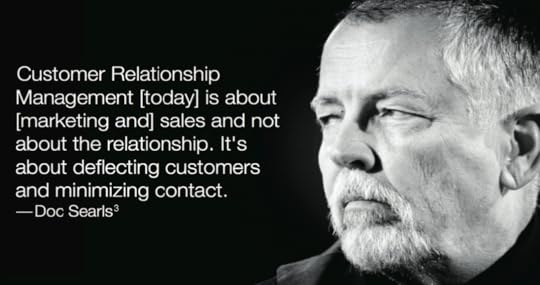Brian Solis's Blog, page 98
November 16, 2015
Uber is Driving a New Generation of Collaborative Marketing
A few weeks ago, I had a very interesting conversation with Fortune’s Sarah Silbert, one that’s still resonating with me. Silbert was exploring Uber’s marketing partnerships and how they might be different than what we see from Lyft and others. Her hunch was that Uber not only amplifies “the on-demand economy—it’s also setting the pace for a new generation of brand marketing.” The story was prompted by Uber’s many partnerships with brands, specifically the promotion to launch the new BMW 7 Series. But that’s just one of many examples. Whether it’s AMEX or Uber for Kittens/Puppies, the company is exploring with many marketing models that I’m sure generate revenue in new and interesting ways.
Her article ran a bit ago but I wanted to share with you our entire conversation here. Perhaps it will not only change how you see Uber but also inspire new marketing opportunities in your work.
Is it accurate to say that Uber is an effective marketing tool for brands that run promos with the service?
Uber is a platform for many things, changing of the guard in addition to testing and promoting new products and services. It’s not unlike how taxis carry advertising on and in its vehicles. But since Uber is a software based platform that combines real-time, mobile and social, it’s a catalyst for a new model for collaboration. Now whether it’s effective because its promotions work or simply because they’re press worthy is yet to be seen.
When Uber runs promotions (with companies such as BMW, Starwood, credit cards, etc.), do you think Uber or the other company benefits more and why?
For the time being, there’s a sense of novelty to all of this that all parities enjoy because of the press generated around every partnership. It’s all very clever though and demonstrates how new platforms open new doors to creative possibilities. As an analyst, and also a Starwood member and AMEX holder, these partnerships, like any loyalty-based program, do help me justify additional use of Uber. More so, the challenge that Uber has is that i has to reach the masses. At the same time, the challenge traditional brands and service face is that they need to reach new connected customers. At the moment, these alliances bring two disparate worlds together.
How much money could Uber be making from these sorts of partnerships?
Honestly, I do not know. Judging by how much money I see brands spending on Youtube or Twitter or other new platforms, I can only imagine that it’s not inexpensive.
Experience is everything…
Connect with me… Twitter | LinkedIn | Facebook | Youtube | Instagram | Pinterest

November 8, 2015
The Insider’s Guide to Digital Transformation and the Path to Innovation
For those who do not know, Altimeter Group was acquired by Prophet, a brand strategy consultancy, in July 2015. The partnership doesn’t change Altimeter’s agenda. In fact, our research will only expand and scale.
Recently Prophet hosted an event to discuss trends in customer experience and digital transformation. It was held in Minneapolis with some of the top local companies in attendance. Co-presenting with me was , Director of Experience Design and Product Innovation UnitedHealth Group, and author of Getting To Thank You: A Practitioner’s Guide to Innovation. Prophet Chief Digital Officer Chan Suh served as moderator.
Somewhere during the conversation, I had to balance speaking with note-taking. The conversation was just that good. It was rich with questions and also experiences, stories of progress and obstructions. There were a few recurring themes that surfaced that are highlighted below.
Digital transformation continues to be a priority among companies. And while many are making strides on specific fronts there are still clear hurdles, including: consensus-building, prioritization, cross-functional collaboration, and lack of expertise. But, it’s clear, progress is inevitable. Innovation in CX is driven by it.
Companies that are able to focus their efforts, even if only minimally, tend to concentrate on the following areas:
1. Know the customer and understand the differences between their trajectory and current beliefs, and their assumptions and investments in the customer journey.
2. The next step is to then reimagine the customer journey based on preferences, expectations and behaviors of the new generation of connected customers.
3. And finally, find the moments that matter. A catalyst for experimentation is to find the “Undercover Boss” moment. Yes, it’s a TV show and the ending is always the same – that moment when an executive discovers empathy. They feel firsthand the challenges that employees and customers face, which leads to greater insights and an improved customer (and employee) experience.

Innovation Takes Innovation
A key trend that is accelerating business transformation is a formal investment in innovation. It can be as simple as an inspirational tour of Silicon Valley beacons such as Facebook, Google or Tesla. More ambitious companies form innovation teams or fund independent innovation centers to focus on key areas of weakness and opportunity.
At UnitedHealth Group for example, Chris Finlay is part of an innovation team that focuses on Human Centered Design (HCD). Finlay believes that it’s this work where he can see the rubber meet the road because HCD is rooted in putting people first.
He says the key is to experiment, collaborate and find better questions to ask that will lead to different outcomes.
From Re-mixing to Re-CXing
In one point during the conversation, Chan asked the audience what they think of when they hear the words “customer experience.” Their responses show how wide-reaching this concept is:
Fragmented journey
Out-of-date touchpoints
Understanding how customers feel
Knowing what customers want
Pain points
Seeing the world through the customer’s eyes
Engaging
Holistic
Consistent
How do customers feel about your brand?
Quite a bit of our conversation explored the non-linear nature of the customer journey. It’s different now than it was even three years ago. It’s vertical, horizontal and cuts across silos. Lines are blurring more than ever between brand and digital, brand and customer experience, and brand and digital.
However, there are two important questions that we zeroed in on:
1. Where are the places where brand meets digital?
2. Where are the places where brand meets experience?
To further make the case for re-cxing, I shared my recent work with Google around mobile-centered micro-moments and how they now play out.
The group agreed that they need to make the shift from focusing on segments that bucket people by age, income, education or promotions to identifying and investing in the moments that matter to different types of consumers. We need to shift our perspective to “moments” vs. persona-based journey maps.
For example, micro-moments begin with intent:
I want to do….
I want to know…
I want to go…
Then we can take an empathetic approach to identifying friction and opportunities in throughout the experience.
When I begin my journey, my first, second and next steps are…
The content, websites and shared experiences that matter in each moment are 1, 2, 3…
The current experience with our company is 1, 2, 3…
When customers visit our site, the following happens (or doesn’t happen)…

Agents of Change
To bring about new investments requires new perspective. Many of those in attendance shared stories about the importance of calling attention to new possibilities and areas of urgency. I call these types of people change agents. Someone has to push and rally “belief” among stakeholders. And change agents are constantly asking themselves, “How can we disrupt the market?”
We examined two scenarios where incumbents opened the door to disruption by following the path of business as usual, rather than investing in their own disruption.
1. Honeywell vs. Nest: Innovation in the thermostat industry was long overdue. Nest not only re-imagined the capabilities of a smart thermostat, but Google acquired it because it actually reconsidered the role of a thermostat in a home. Nest designed their products to be the smart hub of a connected home, which is becoming increasingly important as the Internet of things becomes more pervasive.
2. Blockbuster and Netflix: The famous story of Netflix’s founder Reed Hastings getting charged a $40 late fee when he returned Apollo 13 changed the course of Blockbuster’s fate. Can you imagine? The clerk assessing that charge in that moment had no idea he or she was contributing to the demise of their employer and an entire industry. Blockbuster chose not to invest in Netflix, though Hastings presented the idea to the board, and thus missed the opportunity to develop the new landscape for on-demand media.
Disrupt or be Disrupted
For every company, there is a disruption event on the horizon. The scary question isn’t if, it’s when will this event will unfold (if it hasn’t already)?
Innovation begins by first identifying friction point,, then evaluating the value, opportunity and risk tied to making changes to those points, and finally creating a roadmap to get there. Where your company is on the bell curve, should determine how disruptive you need to be.
Innovative companies share the following traits. They:
Evaluate things faster
Examine vertical models that can have a horizontal impact
Make decisions faster
Test and learn
Iterate
Reward experiments and also failure
ACT
Of course, it’s important to examine who is delivering on customer experience well. The group was very active during this part of the discussion. What everyone agreed on is that it’s not always safe or beneficial to look to your immediate left or right. Some of the most progressive companies are outside of your industry. For example, Starbucks doesn’t view itself as a coffee house; they are a consumer tech company. That lens drives very different business decisions and outcomes.
Other companies that were admired by attendees include:
Sephora – Opened an innovation center to better understand the digital customer and the new relationship between physical and digital shopping.
Capital One – With their acquisition of AdaptivePath, they are redesigning what a bank can be.
Walmart – Opened an innovation center to focus on e-commerce excellence.
IBM – Investing in continued reinvention with a new emphasis on Watson as a platform.
Xiaomi – Customer-led innovation in technology and business models.
Before concluding, Chris Finlay and I shared our views on how each change agent could leave that session to accelerate meaningful transformation:
1. Innovate to create new value.
2. Find the long-term view to blueprint transformation but find short-term opportunities to win in micro-moments.
3. You can’t solve everything right now. Prioritize needs and work.
4. Don’t put unnecessary pressure on yourself.
5. Know where when to have the tension among team member priorities and investments.
6. Work to align beliefs. Establishing a shared purpose removes friction in transformation.
7. Think like the customer and act like a startup.
Experience is everything…
Connect with me… Twitter | LinkedIn | Facebook | Youtube | Instagram | Pinterest

November 6, 2015
Disruptive Technology is Disrupting Behavior
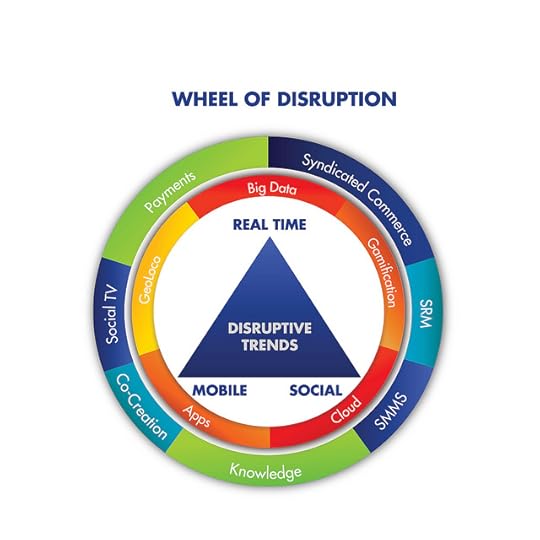
I study disruptive technology, specifically innovative technology that gains so much momentum that it disrupts markets and ultimately businesses. In the past several years, disruptive technology has become so pervasive that I’ve had to further focus my work on studying only disruptive technologies that are impacting customer and employee behavior, expectations and values and affecting customer and employee experiences. I can hardly keep up with today let alone consider the potential disruption that looms ahead in every sector imaginable including new areas that will emerge and displace laggard perspectives, models and processes.
The image above represents the focal point of my work in 2009 – 2012. I called it the “Wheel of Disruption” (WoD) and it was meant to document and convey that the “Golden Triangle” of real-time, mobile and social, surrounded by the cloud, was inspiring incredible innovation and thus producing new and disruptive new apps, tools and services.
It was quickly dated to say the least.
Jump ahead to 2013, and you can see just how quickly disruptive technologies were rising and shifting while affecting or creating new markets, i.e. the so-called sharing economy, which I refer to as the selfish economy, and also the maker movement, connected homes, alternative currencies, ephemeral communication, unbanking and crowd-funding, etc.
This version too was quickly dated.
Let’s take a trip back to the future and visit 2015. What you see below is a working, and crude, model of the the Wheel of Disruption and as you can see, it’s radically enhanced and far more complicated. This is because the rate of which disruptive technology is, well disrupting, is exponential. So the ability to keep up with the next big thing is shaping and reshaping my view of the horizon regardless of how many years you want to look out. But if you notice the differences between this rough model and its predecessors, you’ll notice I’m now focusing on technology’s affect on behavior and the resulting affect on society and how that influences markets.
Disruptive technology’s impact on the short-term is fast and exceptional. Look then at how innovation shapes disruption and the causal effect of disruption on how people go through life, whether personal or for business (even though it’s blurring), you slow evolution to the point where you can track its trajectory.
And, this brings me to the present. As a so-called futurist, I’m now reprogramming my crystal ball to still explore disruptive technology but more so humanity. The Wheel of Disruption was cool and initially effective in tracking technologies that helped prioritize investments toward strategic iteration and innovation. But it was by observing people and the who, what, where, why, when plus to what extent and how shifts in behaviors, expectations, values et al., are bringing to life the old adage of “the future isn’t what it used to be.”
What does that mean? Take a look at the outer layer of the work in progress WoD and you’ll notice that the outer layer is comprised of effects not trends. That’s the layer emulates the ripples of disruption. With each new disruptive technology that acts as a pebble in the water, the ripples that cast forward change the nature of the water’s surface and direction. Here’s the thing; disruptive technology is never going to let up and thus, these pebbles will continue to hit not in just one place, but all over, causing short and long-term transformation on the surface and below.
This metaphor only means this…the future is the result of technology’s impact on society and everything else is upset, rejuvenated or roused as result. Oh the humanities of it all. The future 5 or 10 years out is a selfish one, governed by accidental narcissists who were conditioned to know that the world literally revolved around them and they, whether they wanted it or not, now had the power to…
Put themselves out of work or relevance because of technology.
Gain new expertise that makes them matter to the next economy.
Inspire a new generation of people to change and work toward a common purpose.
Etc. etc.
It’s almost infinite. No, it is.
In a world of “disruptive” apps, devices and machines, humanity becomes the killer app.
Part of the Think Further series brought to you by Fred Alger Management. For more “Think Further” content, please visit www.thinkfurtheralger.com
Experience is everything…

November 4, 2015
Sometimes The Best Experiences Were Meant To Be That Way
Close your eyes for a moment and think about the last time you had a truly great experience… an experience that moved you…that captured your heart, mind and spirit. What about it was so special? Now, bring it to life for someone else…and they’ll do the same.
Experience is everything…
Connect with me… Twitter | LinkedIn | Facebook | Youtube | Instagram | Pinterest

October 27, 2015
Tracking Our Next Digital Steps
It’s been a bit of a whirlwind since the launch of X. In the last two weeks, I’ve hosted conversations about the promise of experience design in London, Düsseldorf, Oslo, Sydney and Geelong.
Somewhere along the Atlantic, I was asked to answer a few questions ahead of my arrival in Geelong for the Pivot Summit by Courtney Crane of the Geelong Advertiser. Thanks to the magic (or curse) of inflight wifi, I was able to make her deadline. But it was more than a Q&A, it was the purpose of the conversation that stopped time to reflect on how this once bustling city is proactively investigating how to build upon its history to adapt for the future.
Geelong is a port city located on Corio Bay and the Barwon River, in the state of Victoria, Australia, about an hour outside of Melbourne. The city is losing its Ford manufacturing and Alcoa aluminum plants and it has many city officials and citizens banding together to explore ways to transform the city from the likes of a Detroit to that of an Austin. Tech is of course at the heart of that conversation.

Geelong: a view from my room at the Novatel. The event is hosted at the end of the pier
I hope this conversation helps Geelong. And, I also hope that it helps you…
First of all, could you define what you see as a “meaningful experience.”
Experience is an emotion that someone feels in response to each engagement with the product, brand and also representatives throughout the customer lifecycle. A meaningful experience is something intentionally designed with reliability, believability and other attributes that align with someone’s intentions and/or expectations.
A meaningful experience is not functionality, capability, brand, customer service or the result of simply transacting with customers.
Is “cultivating an experience” different from brand management?
Brand management and marketing are often associated with the term experience. At the same time, customer support and service is also tied to experiences. But more so, the way that brand, marketing, and support strategists think about experience is often mechanical or procedural. The entire idea of cultivating an experience is understated or under appreciated.
Brand management is tied to brand strategy. And brand strategy is often a byproduct of brand architecture and promise. In the book, I talk about the reality of the “experience divide” which is a simply test in comparing the brand promise to the experience people have and share. To that regard, brand management surely comes into play as the company needs to, and often doesn’t, close the gap because they prioritize pushing the brand story rather than bringing it to life.
X = experience.
It’s the confluence of BX + UX + CX. To bring desired, meaningful experiences to life requires that we don’t start with brand architecture, we instead start with experience architecture. Then brand management has a higher purpose to serve the bigger mission. Experience is the brand. And the experiences people have becomes part of marketing.
Many of our readers own or manage small local businesses- your average cafes, plumbers, retail stores, etc. How important is it for these “average joes” to understand the digital landscape and be able to cultivate meaningful experiences?
Experience is everything. Small business is the heart of any economy. But too many are falling behind in the world as it evolves simply because they are intent to hold onto the way things have always been. Technology is one of the key pillars to delivering and managing meaningful experiences because customers are increasingly living digital lifestyles. They don’t go backward. Their behaviors and expectations only continue to evolve. It’s up to the “average Joes” to adapt or not.

I think about Victor Churchill and the incredible experience they’ve created around the idea of a traditional butcher shop. It’s world famous because their marketing is rooted in the experiences told to and through people who love it. I personally had to visit it and was completely enchanted by the experience. But what’s important is that they intentionally set out to create this experience and everything they do becomes a form of experience management.
Are those who think simply having a good product and good customer service is enough to be successful kidding themselves?
We live in a world where having a good product and/or good customer service is a competitive advantage. And it’s true for the time being. But when you study where consumerism is shifting and ultimately where it will be in the short while, the desire for all around experience, before, during and after buying, is the new “good enough.”
Studies show that people are willing to pay up to 25% more for a product because they believe they are going to have a great, productive or “experiential” experience. Competing for the hearts and minds of customers is quickly replacing competing for their wallets.
Can a mediocre product or business thrive by creating an exceptional experience around it?
I’m sure that dazzling customers this way has and will work somewhat until they recognize that they’re not able to do what it is they set out to do the way the intended to do so. Mediocrity kills. Competing for it is a short-term game. An exceptional experience means that you understand customer friction, aspirations, frustrations, vision to drive your innovation and overall experience architecture.
Technology and the online world is evolving so quickly. What key advice do you have for businesses looking to adapt and make smart decisions?
Technology is an enabler for a bigger vision. It is not the solution. Too many businesses look at technology as a way of scaling the ideas, processes, and metrics of customer engagement models of yesteryear. Start by studying the experience gap. Look at how customer behaviors and expectations are evolving. Look at your competitors, but also look at other companies in other industries the manage the types of customer experiences and relationships you want. Following the path of business as usual and using new technology to achieve it, does not change your core.
Iteration improves things.
Innovation opens new doors and creates new value.
Disruption shifts behaviors and markets.
Every business must do at least two of the above.
Are there any key trends in the digital world you believe Australian businesses should be aware of right now?
One of the reasons I believe UX is so important in the formula of experience architecture is inspired by the consumerization of technology. Without going through every trend that Australian businesses should watch, we should focus on immediate expectations. Apps like Uber, Tinder, Clear, et al., are changing how people navigate apps to accomplish goals or trigger outcomes. How they interact with these apps is one part. Add to that new services such as AirBnB and you start to see that people want services that cater to their evolving needs.
The biggest thing to realize here is that digital is changing how people make decisions and how they want to do business. They expect to engage EVERY company the way they do with their personal apps. This means that the entire funnel, the entire customer journey, each and every touch point from the Web, to sales and service teams to physical stores to CRM must be re-imagined to feel more natural to the way digital trends are impacting people.
Experience is everything…
Connect with me… Twitter | LinkedIn | Facebook | Youtube | Instagram | Pinterest

October 22, 2015
Xcited to Announce That X: The Experience When Business Meets Design is Now Available
Three-and-a-half years in the making, I’m proud and also relieved to finally announce that X is now available online and in a store near you. I can’t tell you how important this is to me. There were several times along the way including up until the end when I thought this book would never see the light of day. I can’t wait to share it with you.
I tend to spend most of my time sharing my work across the web and at conferences everywhere. If you can, I ask for your support with this book. The first week is very important to authors. Please pick your favorite retailer/etailer and give it a read. Help me spread the word! And please, go for the print book. The story of the book is a real life case study of the book’s purpose.
Seriously. Thank you for all of your support now and over the years.
Amazon | BAM | Barnes and Noble | 800CEOREAD
What is X?
X represents experience. It’s that je ne sais quoi that makes something so special. This book is about X, creating such memorable moments for your customers through every encounter they have with you brand—all day, every day.
While everyone is talking about experience, and have been for years, few have shared what an experience really is, why it’s important at every level, and more so, how do design meaningful and shareable experiences.
X is meant to be an experience in of itself. Its unique approach explores why great products, creative marketing and delightful customer service are no longer enough to succeed. Cleverly designed as an “analog app,” the book introduces the role of “experience architects” to guide readers through the art and science of designing experiences.
Xclusive Facts about X
This is my fourth book with Wiley.
X is the first of the four to feature a cover without a chain (we’re finally breaking free from the shackles of legacy and mediocrity).
I’ve worked on this book every weekend and many weeknights for the last few years.
I took a break from X to publish WTF (What’s the Future of Business). WTF was never on the roadmap and was introduced by Wiley as an ebook originally to serve as a bridge between End of Business as Usual and X. What a wonderful detour!
The original manuscript was tallied at 150,000 words and later revised down to ~40k.There was talk about releasing an uncut version. Instead, I’ll release all of the unpublished chapters as PDFs eventually at Xthebook.com.
The book was designed in partnership with Mekanism, which is a big deal for an award-winning advertising agency to help on a project like this. We go back years and I’m thankful for their friendship.
The shape of the book is modeled after an iPad Air 2.
There is no table of contents in the book. It is instead designed to emulate the apps many of us use on our smartphones and tablets.
The chapter format is also patterned after software releases, trying themes together rather than traditional numeric progression.
The book features original artwork and frameworks to introduce visual storytelling into the experience. The complex process of ideation and development delayed the book several times.
The cover was originally designed in 2013 and redesigned in 2014. The new cover was was published on Amazon and remained there until a few months prior to official launch when we decided to go back to the original design. This is the alternate cover…
The “X” on the cover is not a product of Photoshop, it’s physically cut and built multi-layer stack of Plexiglas with each layer featuring a different texture.
To photograph what would be the cover, the X was placed on a flat screen TV set on its back shooting colors through the layers in a dark room.
During the shoot, we also captured video to showcase the brilliant spectrum of colors, which would become a teaser video to sell the publisher on the concept of the cover design. The video was shot in 2013 and not shared publicly until 2015.
When I first saw the X model live, I expected to see something that stood several feet tall. Instead, I was surprised to learn that it stands at only 5 inches. It looked so big on TV!
The framework for experience architecture introduced in the book was designed to form the letter “X.”
When the book initially went to press, the amount of color saturation on each page initially jammed the process. Everything was re-calibrated to work but not without slightly delaying the release.
Connect with me… Twitter | LinkedIn | Facebook | Youtube | Instagram | Pinterest

October 19, 2015
How To Unify Your Sales, Service and Marketing Departments Around Customer Experience
Guest post by Omar Akhtar (@obakhtar), Managing Editor, Altimeter Group, a Prophet company
Imagine you’re getting ready to drive your car. But when you turn on the engine, you get a mobile notification telling you that your oil needs to be changed, and it gives you a link to the nearest dealership with a 10% discount coupon. You’re left surprised and delighted by the sheer, almost magical convenience of it all. But is that event classified as a sales, service or marketing interaction? The correct answer is: all of the above.
Marketing is often regarded as the de facto custodian of the customer experience, especially when it comes to digital engagement. Hence it makes sense for it to have the best, most advanced tools for providing the delivering the optimal experience. But in today’s world of always connected, always on experiences, customer experience management is no longer just the responsibility of marketing, or even sales or service. Today, the entire company is responsible for the customer experience. And hence, the technology for customer experience management must allow multiple teams within a company to operate it in a unified, way delivering a seamless customer experience across all touchpoints.
For companies that have been moving towards the idea of unified “marketing cloud” or an integrated system of tools to operate all marketing channels, we’re saying, think bigger. To truly recognize the customer across each touchpoint, and provide a seamless experience at every interaction, the technology strategy must evolve from “marketing cloud” to the “customer experience cloud.”
Of course, that’s no easy task. Raise your hand if you’re tired of being told to “break down silos” but you don’t know where to start. Raise your hand if you want to build a great customer experience but you can’t define what that is. And raise your hand if you’re in charge of buying marketing technology but are overwhelmed by the thousands of software options that are available to you.
A new report from Altimeter, authored by myself and Charlene Li, titled: “The Customer Experience Cloud: How To Unify The Organization Around A Seamless Customer Experience” is written for anyone who identifies their organization as having these problems. The new reality of commerce is that brands are expected to be present on an ever-increasing number of channels, both online and offline. And customers expect to be recognized as the same unique individual across all of these channels. They want personalized content, real-time engagement, recognition across devices and serendipitous discovery all at once. This requires a major upheaval not just in the technology being used, but the organization of the company as well.
In this report, we’ve provided the essential technological and organizational components that companies need to unify the efforts of sales, service and marketing around building a seamless, cross-channel customer experience. Based on research interviews with leading brands such as Nike, McDonalds, General Motors and General Electric, we’ve found the common best practices for companies working towards this goal. And finally, we’ve created a starting guide for companies on choosing the right technology to support their unified customer experience plan, with an overview of the leading technology vendors that can help deliver on this vision.
Putting the customer experience cloud into practice is a major effort that will mean reorganizing teams, setting new governance, buying new technology and establishing new processes. It is nothing short of a comprehensive digital transformation. With so many parts of the puzzle required to fall in place simultaneously before any real execution, the most daunting part is knowing where to start. And with this report, we believe we can give companies that crucial starting point for how to adapt, and thrive in the face of what we think will be a major disruption in the way customers interact with brands in the digital age.
Omar Akhtar is the Managing Editor for the research team at Altimeter, A Prophet Company where he oversees the editorial process behind all of Altimeter’s publications, including its research reports, daily blog and multimedia content. In addition, he conducts and publishes research in the area of marketing/ customer experience technology

October 15, 2015
Wolfpack App is a Mobile Social Nichework for Guys to be Guys – Is this the Dawn of Social Nicheworks?
 I thought I’d seen it all. Wolfpack app is a new mobile-centered, social network that helps guys connect with like-minded buddies around interests and events. When the news of Wolfpack’s debut landed in my inbox, I initially disregarded it as yet another “bro” app. I live in Silicon Valley where bro culture is a widely recognized problem. Too many of these bros after all are blamed for the lack of diversity and respect in startups among many other things that we can discuss later. But this isn’t yet another bro app by bros I quickly realized. It’s all about the bromance and quite honestly, real world friendships. Imagine that?
I thought I’d seen it all. Wolfpack app is a new mobile-centered, social network that helps guys connect with like-minded buddies around interests and events. When the news of Wolfpack’s debut landed in my inbox, I initially disregarded it as yet another “bro” app. I live in Silicon Valley where bro culture is a widely recognized problem. Too many of these bros after all are blamed for the lack of diversity and respect in startups among many other things that we can discuss later. But this isn’t yet another bro app by bros I quickly realized. It’s all about the bromance and quite honestly, real world friendships. Imagine that?
Nile Niami, a movie producer turned app developer, was inspired to create Wolfpack by a friend who was recently divorced. According to Niami, his friend was married for 20 years and lost track of all his old school friends. But what really struck me about the app was the tech, what it could ultimately mean, and also the ability for the app, though invisible to the user, to align geo-location, mobile, moments and interest graphs to build a series of hyper-localized nicheworks aka social networks based on interests in real-time. I realize this paragraph is full of buzzwords. Said another way, Wolfpack works like Foursquare for friendships and occasions.
Once the app is installed, Wolfpack asks users to select interests and hobbies. Then based on location, the app suggests upcoming events or offers the ability for users to create their own. At first pass, for example, I found several relevant bar nights, game days, softball and basketball pickups, and yes, even movie nights. The app also does its thing to connect me to potential friends and also upcoming events.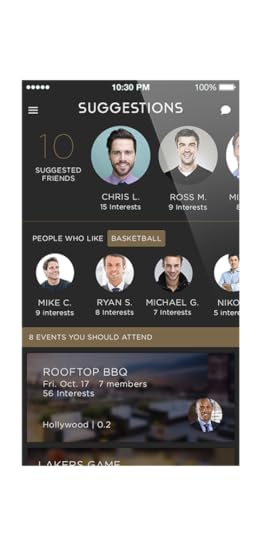
I travel pretty much all the time. And when I’m home, I’m usually working on my next research or book project. Something like this makes sense when I want to catch a San Francisco Giants or 49ers game, local music or a concert by my favorite and secretly favorite artists. Even though I have local friends, they’re not always available. And, they’re definitely not hanging out wherever I may be traveling. Furthermore, there are some things I like to do things locally that my best friends would rather not, although they sometimes indulge me, such as riding motorcycles, driving old cars and pursuing the Bay Area’s best cheeseburger.
While there are several existing networks and apps, the promise of Wolfpack is that it facilitates momentary friendships that offer realistic shots at longer-term friendships.
Though focused on dudes, the platform could be re-purposed for any interest-based nichework. And, this is what really interests me.
Path, founded by Dave Morin, once tried to limit connections to Dunbar’s famously misinterpreted number of 150 friends rather than Facebook’s cap of 5,000. Although it limited the number of ties, Path still focused on the social graph rather than true interest graphs. Wolfpack though represents a new genre of hyper-focused apps that attempt to put the social back in social networking—at least in the real world anyway. I honestly hope to see, and use, more apps connect us with people who can enhance our real world relationships even if it’s through digital means.
Connect with me… Twitter | LinkedIn | Facebook | Youtube | Instagram | Pinterest

Wolfpack is a Mobile Social Nichework for Guys to be Guys – Is this the Dawn of Social Nicheworks?
 I thought I’d seen it all. Wolfpack is a new mobile-centered, social network that helps guys connect with like-minded buddies around interests and events. When the news of Wolfpack’s debut landed in my inbox, I initially disregarded it as yet another “bro” app. I live in Silicon Valley where bro culture is a widely recognized problem. Too many of these bros after all are blamed for the lack of diversity and respect in startups among many other things that we can discuss later. But this isn’t yet another bro app by bros I quickly realized. It’s all about the bromance and quite honestly, real world friendships. Imagine that?
I thought I’d seen it all. Wolfpack is a new mobile-centered, social network that helps guys connect with like-minded buddies around interests and events. When the news of Wolfpack’s debut landed in my inbox, I initially disregarded it as yet another “bro” app. I live in Silicon Valley where bro culture is a widely recognized problem. Too many of these bros after all are blamed for the lack of diversity and respect in startups among many other things that we can discuss later. But this isn’t yet another bro app by bros I quickly realized. It’s all about the bromance and quite honestly, real world friendships. Imagine that?
Nile Niami, a movie producer turned app developer, was inspired to create Wolfpack by a friend who was recently divorced. According to Niami, his friend was married for 20 years and lost track of all his old school friends. But what really struck me about the app was the tech, what it could ultimately mean, and also the ability for the app, though invisible to the user, to align geo-location, mobile, moments and interest graphs to build a series of hyper-localized nicheworks aka social networks based on interests in real-time. I realize this paragraph is full of buzzwords. Said another way, Wolfpack works like Foursquare for friendships and occasions.
Once the app is installed, Wolfpack asks users to select interests and hobbies. Then based on location, the app suggests upcoming events or offers the ability for users to create their own. At first pass, for example, I found several relevant bar nights, game days, softball and basketball pickups, and yes, even movie nights. The app also does its thing to connect me to potential friends and also upcoming events.
I travel pretty much all the time. And when I’m home, I’m usually working on my next research or book project. Something like this makes sense when I want to catch a San Francisco Giants or 49ers game, local music or a concert by my favorite and secretly favorite artists. Even though I have local friends, they’re not always available. And, they’re definitely not hanging out wherever I may be traveling. Furthermore, there are some things I like to do things locally that my best friends would rather not, although they sometimes indulge me, such as riding motorcycles, driving old cars and pursuing the Bay Area’s best cheeseburger.
While there are several existing networks and apps, the promise of Wolfpack is that it facilitates momentary friendships that offer realistic shots at longer-term friendships.
Though focused on dudes, the platform could be re-purposed for any interest-based nichework. And, this is what really interests me.
Path, founded by Dave Morin, once tried to limit connections to Dunbar’s famously misinterpreted number of 150 friends rather than Facebook’s cap of 5,000. Although it limited the number of ties, Path still focused on the social graph rather than true interest graphs. Wolfpack though represents a new genre of hyper-focused apps that attempt to put the social back in social networking—at least in the real world anyway. I honestly hope to see, and use, more apps connect us with people who can enhance our real world relationships even if it’s through digital means.
Connect with me… Twitter | LinkedIn | Facebook | Youtube | Instagram | Pinterest

October 12, 2015
Experience is the Brand: Why this is the time for experience architecture
While I was in traveling in Europe, my friends at 800CEOREAD reached out to talk about X. I was so focused on production and printing that I’ve almost neglected letting people know that the book is finally getting released! I took the time to answer a handful of questions. But, I didn’t reply quickly. I took my time to share the depth of what X explores and how it will help you.
“Here’s the thing. Experience is the brand. Meaningful and shareable experiences are now forms of marketing.”
—Brian Solis
800-CEO-READ: You begin by telling us that marketing and advertising are generally prioritized ahead of investing in experience, yet it is a customer’s experience that leads to the most influential and effective advertising there is—word of mouth among customers. So, how do we go about changing that mindset, and redirecting resources accordingly?
Brian Solis: You’re exactly right and that’s where this story begins. Customer experience means just that. It’s the experience a customer has. What makes this so important is that in a connected economy, it’s also about the experience that people have and now share online. That moment stays on the internet. It doesn’t go away. And over time, shared experiences build upon one another forming a collective ensemble of people’s sentiment toward a company or product.
And here’s the thing. Experience is the brand. Meaningful and shareable experiences are now forms of marketing.
Today, companies react to experiences and try to shape them by marketing at people. As a result, experiences are unpredictable and left to chance. Why is that okay?
In X, which stands for “experience,” I introduce experience architecture over brand architecture so that companies can shape experiences by first designing them and bringing them to life in every aspect of the customer journey. Because that’s what customer experience is, the sum of each engagement a person has with a company, at every touchpoint, throughout the customer lifecycle. More importantly, customer experience is a series of emotions that marketing can’t shape, nor should it, in the long term.
Experience architecture becomes the new brand style guide to inspire and govern the entire journey… starting with company values, vision, and product and support design
800-CEO-READ: On the other hand, you share the story of a great Coca-Cola campaign—in which drones delivered cokes to migrant workers building the skyscrapers of Singapore—as a great example of a brand delivering an experience, or perhaps an experience delivering a brand. But, in this case it was surely a marketing team that came up with the “happiness” slogan, pinpointed the optimal time and most refreshing time for a Coke (during a work break at a physically demanding job), designed the ad campaign, made the savvy decision to work with the Singapore Kindness Movement to deliver thank you messages from Singaporeans on the ground along with the Cokes, and captured it all on film. This seems like an example of an ad campaign (as is the Nike soccer ad you reference soon after) delivering the experience—even if it isn’t a traditional campaign. Where is the overlap of advertising and experience architecture occurring right now? Is the line being erased? Should it be?
Brian Solis: These are indeed examples of “experiences as marketing” and marketing of experiences. The difference is important. The book covers the entire journey and in this particular section, I intended to introduce the idea that experiences as marketing work when the brand stands for something. It’s one of the reasons why I share Coca-Cola’s mission statement. These examples bring to life the experience the brand states it will deliver. And it attempts to do so beyond marketing but also throughout the customer journey.
However, I share stories throughout the book that capture best-in-class experiences in each moment of truth. The only company I discuss about being methodical about experience architecture at every step is Apple, chapter 8.1. There I detail every step of the iPad journey. The chapter was so detailed that it was a small book by itself. I think we cut 4,000 words from that section alone. It really is quite remarkable to what extent Apple thinks through the entire experience. They’ve literally designed it. And, I guess that’s the point. The importance of design is elevated to the executive level. Sir Jony Ive is much more than the company’s chief design officer, he’s also its chief experience architect.
800-CEO-READ: I’ve mentioned the Coca-Cola ad, and Apple is featured throughout the book (including the full treatment you discuss above) as a company that exemplifies delivering great, seamless customer experience. And they both do deliver great experiences—so great that both are widely recognized as addictive experiences, and not necessarily healthy at the levels we’re using them. Is there any onus on companies to craft experiences that not only benefit their bottom line, but also take into account the effects of that prolonged experience on the health of their consumers?
Brian Solis: I share many stats in the book to help offer new perspective and also create a sense of urgency. In one stat I share that customers are willing to pay as much as 25% more for a product they believe they will have a great experience with it. Imagine if a company invested in experiences throughout the lifecycle. Not only is profitability on the table but customer retention also increases. Great experiences deliver great ROI. So, yes, the onus is on companies to invest in experience and new models to support them, to cultivate long-term, lucrative relationships that are also mutually beneficial.
The key word here is relevance. You either compete for it or you don’t. But I promise you that if you do not disrupt yourself, the gift of disruption will be given to you by someone else. There is a disruption event on the horizon of every business and it’s just a matter of time for everyone.
Oh, and stop looking at your competition to see what they’re doing. Start looking at other industries that are delivering on amazing experiences and apply it to your work. Anything less is just an excuse.
800-CEO-READ: You mention that if we are going to focus on specific technologies, it should not be social media technologies but those we implement internally and in our front-line customer interactions, and that we must be deliberate about that process instead of implementing the latest “shiny object” technologies, platforms, or devices. What advice can you give in this regard?
Brian Solis: Customer experiences are broken because the customer engagement model is broken. Today, CX (customer experience) is governed by each different group that’s responsible for their portion of the purchase funnel. They use different technologies, are managed by different and sometimes competing metrics, are striving to achieve varying forms of reach and engagement that may or may not complement one another. Said another way, brands are made, and not cultivated through experience or relationships for the most part. Technology is often a crutch or a band-aid rather than an enabler of a vision for customer experiences.
For the most part, strategists still over-rely on broadcast approaches to talking at markets and audiences, use technology to scale and pursue efficiency at the cost of intimacy.
We can’t think technology first. I call that mediumism in the book. We have to think of people and experiences first. Then technology brings to life, in meaningful ways, experience architecture as designed and as optimized for each platform.
800-CEO-READ: You tell us that the borders between brand experience, user experience, and customer experience are crumbling, and that these fields are largely becoming one connected discipline. How is that happening, and how does a “data artist” support all of this? Following that line of thought… this reminds me a bit of the blurring of boundaries between anthropology and sociology. And, in fact, you describe how many companies are now hiring anthropologists to help study human behavior and improve their user experience. That’s fascinating to me. Oddly, it seems like most people agree that, as technology advances, considering human relationships and human nature matter even more. Do you think this will become the norm in companies across the board?
Brian Solis: Well, to be clear, I say that CX + UX + BX = X (Customer experience + user experience + brand experience = Experience). It’s a simplified formula to say that we should all work toward experience and that the principles and ambitions of each should ratchet up the organization under one, common, executive order. Experience and thus brand and customer relationships is the culmination of technology + humanities. I go into great detail about the advantages of each discipline and how each (and more) can and should work together.
One of the problems is that many executives are blind to the very people they need to thrive. They don’t live their brands the way customers do. So the idea of social science, including anthropology, ethnography, psychology, et al. offers a human-centered perspective that then serves as the essence of empathy and ultimately as the mission and purpose of a brand and the experiences it wishes to bring to life. A data artist as I introduce is not the data scientist that “Moneyball” fanatics are investing in as big data becomes bigger. Instead, it’s a role that looks at small data and applies human filters to ask different questions, which begets different answers.
800-CEO-READ: How does storytelling tie into all of this, and how can we tell a story through an experience—throughout time, in real time, and in real life? How does that change the stories we tell?
Brian Solis: I explore the different approaches to mapping customer journeys including traditional journey maps, experience maps, and experience flows. I also take a step back to learn about storyboards, specifically Disney’s and Pixar’s approach to them. I initially thought that storyboards were a form of illustrating an animated movie to save money on costly edits prior to production. That’s only partially true.
After spending time with former Pixar artist Nicholas Sung, I learned that storyboarding is the most important part of every story ever produced. It forces artists and storytellers to think through the story arc, characters, moments, to make each believable, engaging, entertaining, and more personal.
Storyboards are so critical to experience architecture that I dedicated an entire chapter to the subject. The process, as you see, forces brands out of the rut of creating brand-centric stories from a creative perspective and instead start from a position of empathy. The resulting stories are not only different, they’re meaningful and believable. In the book, I talk about AirBNB’s “Project Snow White” and how the company worked with Sung to rethink (and better understand) the renter and owner journeys. They learned so much more than they imagined. It completely changed the company’s approach in every moment of truth because they understood all of the dimensions affecting it before, during and after each stay.
“One of the problems is that many executives are blind to the very people they need to thrive. They don’t live their brands the way customers do. So the idea of social science, including anthropology, ethnography, psychology, et al. offers a human-centered perspective that then serves as the essence of empathy and ultimately as the mission and purpose of a brand and the experiences it wishes to bring to life.”


